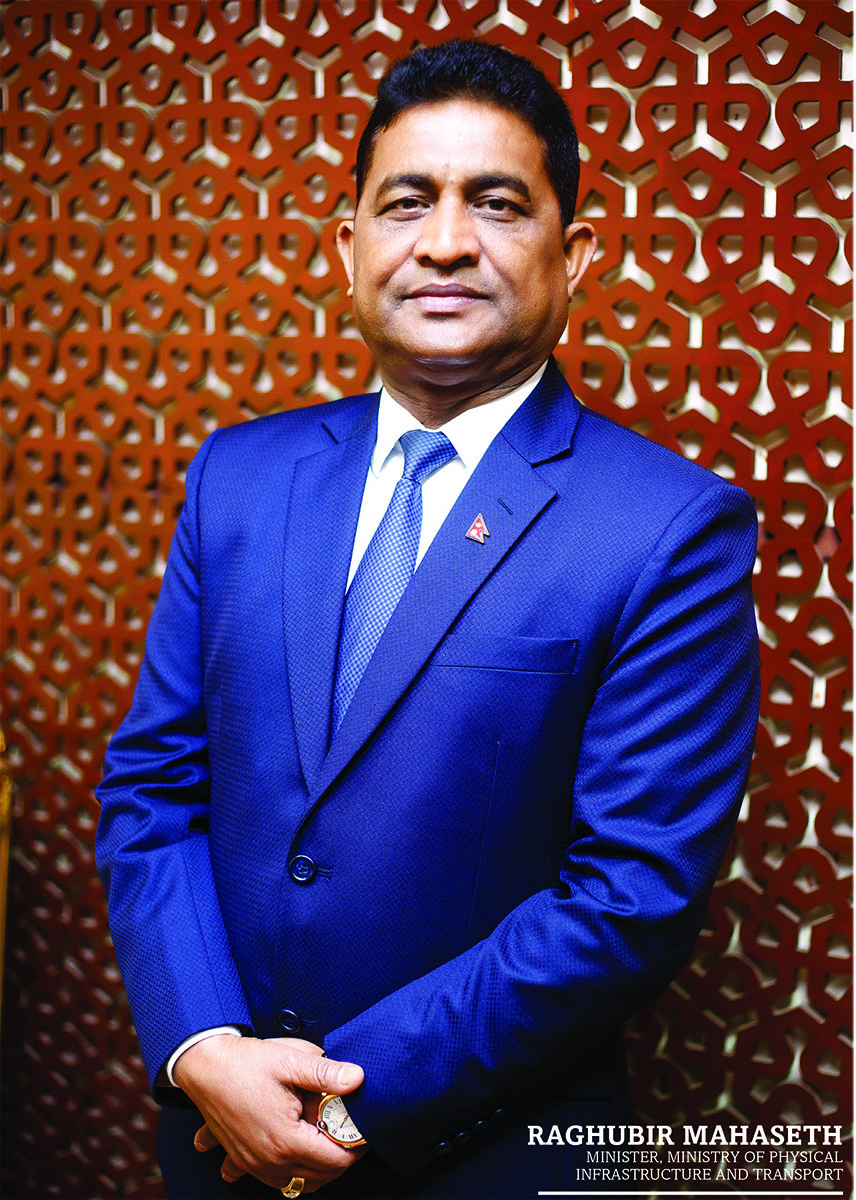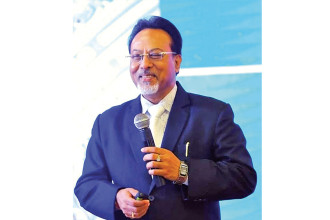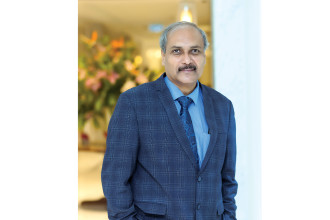
Raghubir Mahaseth
Minister, Ministry of Physical Infrastructure and Transport
Raghubir Mahaseth is the current Physical Infrastructure and Transportation Minister of Nepal. Born in Dhanusha, he is a standing committee member of the ruling Nepal Communist Party and elected Member of Parliament from Dhanusha Constituency-4. Mahaseth was also elected to the Constituent Assembly (2010-2012) from Dhanusha Constituency-5 and was the Minister of Irrigation in 2011. He holds a Bachelor’s degree in Engineering from Birla Institute of Technology, India.
Dibesh Dangol of B360 interviewed Mahaseth to get insight into the physical infrastructure and transport works happening in Nepal, the situation of Nepal-China Cross Border Railway line and purchase of 2 DEMU trains from India, and abolishment of the transport syndicate system in Nepal. Excerpts:
In March 2018, after being appointed Minister of Physical Infrastructure and Transport Ministry, you said that Chinese rail would arrive in Nepal within five years, i.e. 2023, which will connect Pokhara and Lumbini through Kathmandu. Could you tell us about the status of the Nepal-China Cross Border Railway Line?
The pre-feasibility study regarding this project was completed in 2018 and we received the report in February 2019. The report suggested that due to the geographical situation of Nepal, Detailed Project Report (DPR) needs to be prepared for which we are having multiple meetings with the Chinese government. The fourth meeting was held a couple of months ago between General Secretary of MoPIT and representatives from the Chinese government, and the fifth meeting is going to be held in Kathmandu soon in which the final conversation regarding DPR will be discussed. DPR will take a year to prepare, after which the process regarding construction work will start; first through a bidding process. Generally, it would have taken three years to complete such project on plain surface area, but because of the geographical condition, multiple tunnels need to be dug, which is why it will take a minimum of 4-5 years. The railway line will be about 76 kms and the construction cost will be around $3 billion.
As for the construction model, we still haven’t decided which model we will be using; full investment from government, FDIs or Public-Private Partnership. Even if we don’t receive FDI or go for PPP model, the government has to invest in the project. The government is ready and will be constructing this railway line.
On March 21, the Cabinet permitted the Department of Railways (DoRW) to begin the purchase of two DEMU trains from India. Balaram Mishra, Director General of DoRW said that once a written letter of the decision taken by the Cabinet is received, DoRW will send the request letter to Konkan Railways for rail procurement agreement, and after that it may take around three months to receive the trains. The agreement was signed in May. What is the status and where will these trains operate and who will benefit from this project?
According to the proposed cross border railway line which will connect Jaynagar of India and Kurtha of Nepal and is about 69 kms, the decision regarding purchasing two DEMU trains from India through G2G model was made. We went through this model because Nepal doesn’t have its own train manufacturing plant, we didn’t want to take Indian trains on lease and wanted to have our own trains with Nepal’s flag on them. We have already sent the payment to the corresponding party and they have told us that we will receive the trains within 90-120 days.
After we receive the trains, which I think we will be receiving within a month, we will be moving towards operation process. Due to the recent floods in that area, about 90 metres of the track was damaged and repaired within a week. For operations, initially we will be bringing a few technical experts (about 5-7) from abroad for a certain time because we lack such experts in Nepal. Those foreign experts will also be training our technical workers so that they can learn and operate. As for security and other operational activities, Nepalis have already been provided jobs for this project.
This project will largely benefit all Nepali travellers and tourists (both from Nepal and India). The railway line connects Janakpur which is known for Janaki Temple and is the birthplace of Sita, and attracts more than three lakh tourists in a year. So, there is a huge scope of increasing tourism in Janakpur, and via Janakpur to all over Nepal through this railway line. Alongside, it will also benefit industries, businesses and traders of both Nepal and India.
What are your plans for nationwide railway lines?
Within 10 years, we have planned to construct 15,000 kms of highway roads and 2,800 kms of railway lines. The railway lines will connect major cities of Nepal like East-West Electric Railway Line which will connect Kakarbhita, Jhapa and Gadda Chauki, Kanchanpur. The DPR regarding this railway line has already been prepared along with the cross-border railway line. The prefeasibility studies of Kathmandu-Kerung and Kathmandu-Birgunj railway lines have already been done and DPR regarding these railway lines will be prepared within a year and a half. Likewise, the survey work of Kathmandu-Pokhara railway line has already started and we have reached the final consultation process. The Kathmandu-Pokhara railway line will also be linked with Lumbini of which we have reached the final consultation process. We are positively working towards achieving our target to complete 2,800 kms railway line within 10 years that will connect major cities, provide transportation ease to Nepali passengers, traders and tourists, and lead to the development of the country.
Contractors and related associations have raised disheartened issues regarding government not including such stakeholders during policy planning process. Is it true?
It’s not true that we haven’t held any meetings at all with contractors and related associations. We have held multiple meetings with stakeholders on a timely basis to discuss about policies and ask for their recommendations. As per mutual agreement between the construction companies and the Government of Nepal, Federation of Contractors Association was established headed by Minister of Physical Infrastructure and Transport which is under the Ministry of Physical Infrastructure and Transport, Government of Nepal. What they should realise is that we can’t take all their recommendations and make them into policies because we have certain guidelines to follow as well, and whatever the Ministry is doing is for their and the country’s betterment.
What actions can be or are taken against contractors who are stalling government projects?
Before the present government, construction or infrastructure development projects were in chaotic condition. I even found out that the projects that had completed the bidding process in 1994 weren’t even started or progressing. We have been able to overview all such projects, manage them and move forward positively.
While investigating many such stand-still projects, I found out that the contractors had taken the initial advance that the government used to provide i.e. 20% of the total construction fund which they don’t have to pay interest on and had invested in other sectors and not into the construction process. Due to such occurrences, we have decided to be strict on such matters and have changed the policy of giving the initial fund to just 10% rather than 20%. The initial 10% of funds will also not be given wholly; initially 5% will be given and the remaining 5% will be given after analysing the pace of construction.
Alongside, we have started to take action against those contractors who have taken Nepal Government’s money or advance but haven’t produced any outcome in the construction process and have refused to pay the money back to the government. The action that we have taken against such contractors include fine upto 10% of the total project cost and recently we have fined a construction company Rs 5.7 crores. We have found many such cases and actions are being taken accordingly.
Though there have been improvements by applying such policies, there are still contractors whom we are closely watching. We have even told contractors if they want to work, complete the projects and be involved in the country’s development projects, the Ministry and the government are ready to co-operate with them and extend their deadline according to rules. If not, we will be blacklisting them. We do want construction businesses to prosper in the country. They shouldn’t compromise on their work quality and neither will we. We have halted payments of contractors and projects that have lacked quality and weren’t built according to the specifications given to them.
Because we have advanced strictly regarding such issues, the construction businesses have also become serious and positive about government projects which I think will lead to greater good in the country.
In the past, you have claimed that the Ministry had been facing problems from provincial and local government as they have returned some of the projects that the central government had handed over to them. How is this being addressed?
Before 2018, there was a Central Administrative System in Nepal, and in February 2018, Provincial Government System was effectively introduced because of which many previous laws and policies had to be changed. Due to this transition, many projects were distributed to the provincial and local governments. We also requested these governments that if they aren’t able to properly conduct these projects, we will be assisting them, and if they can, they should conduct these projects according to the budget we sent them. Initially, there were problems, but now 70% of such problems have been resolved and the remaining 30% will be resolved within this fiscal year. I don’t deny that such problems haven’t occurred and it is natural for such friction to occur because it has just been a year and a half that we have progressed to the current government system.
Is it true that the Physical Infrastructure Ministry’s interest in Kathmandu-Terai Fast Track Road project is delaying DPR endorsement and you are not happy that the Nepal Army has been given the sole authority to construct the multibillion rupee project as you want your Ministry’s involvement in the construction process?
There is no truth in this statement at all. The sole authority of this project has been given to Nepal Army by the government and our only role in this project is to send the budget to Nepal Army. The DPR of this project is to be endorsed by Nepal Army and not by MoPIT or Nepal Government. We haven’t been authorised to interfere either in their work or the project, and we haven’t even thought of doing so. The role of the government is to endorse the alignment only and not DPR. So, whatever statement or news has been published in the media regarding MoPIT’s and me delaying DPR endorsement of the Fast Track Road project is a complete hoax.
What is Transport Management Authority? What are the issues that this department under MoPIT will be looking after?
The Transport Management Authority is a governmental body under Department of Transport Management (DoTM) and MoPIT that will be formulating short and long term policies and strategies for the betterment of public transportation system. For the initial stage, we are planning to establish the Transport Management Authority for Kathmandu valley only and call it Kathmandu Valley Public Transportation Authority. Regarding this, a bill was presented in the Parliament a few weeks back and positive discussions have been going on. After the bill gets approved, the authority will be implemented here in Kathmandu valley. We have also already given responsibility to Sajha Yatayat, in which Nepal Government has 59% shares, to purchase and operate 300 electric buses. If the bill gets approved as per submission with no changes, the private sector and local governments can also participate and play a vital role in managing transportation system of the country.
Since the authority will be established in Kathmandu valley initially, its responsibilities will be to make public transportation accessible, easy, reliable and safe by planning, managing and operating public transportation inside the valley. The authority will be fixing routes for public transportation and setting vehicle standards along with introducing electronic payment and information system.
As per the proposed bill, the Mayor of Kathmandu Metropolitan City will work as the Coordinator for the Public Transportation Council, along with Mayors of Lalitpur and Bhaktapur Metropolitan Cities as Members of the Council. A CEO with prior experience of working in such sectors for at least a decade will be appointed for the authority and s/he will be responsible for executing the administrative works of the authority.
One of your main agendas after being appointed as Minister of MoPIT was to scrap the syndicate system and transform the transport associations into companies. To make this happen, MoPIT even froze the bank accounts of transport associations who refused to transform into companies and follow the government’s decision. Recently, the government decided to unfreeze the bank accounts of those transport agencies that converted into companies and agreed to support the government’s movement to end the syndicate system. How would you evaluate this scenario?
The strict decision we took against transport associations who weren’t complying with us was absolutely the right decision. The majority of such associations have converted themselves into companies. Those few who are still not complying will not be getting route permits. We had given them a deadline date until June 1, 2019 to convert into companies. From July 19, 2019, the registered transportation companies have begun operating all over Nepal and I can proudly say that the syndicate system has completely ended in Nepal. We decided to unfreeze the bank accounts of the supportive companies because we wanted to set an example that the government is not their enemy and wants to work with them to make better systems and policies for the country.
Before June 15, 2018, the transport associations had sole involvement in such activities and the government had no control over them which lead to the syndicate system and poor management of transportation all over the country. After that, the government decided to change the system so that the problems caused by syndicate system can be solved and managed, job security can be provided to employees, and transport entrepreneurs can come under taxation system.We have accomplished this with those transportation entrepreneurs who shared similar views, and also with the cooperation of the Ministry of Home Affairs and Nepal Rastra Bank. Above all, we are grateful that these associations didn’t organise any major strikes or bandhs which could have caused major transportation problems in the country.






